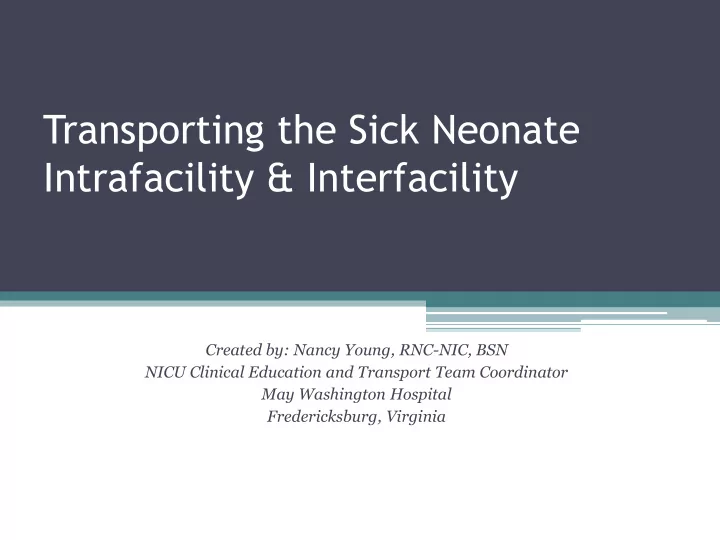

Transporting the Sick Neonate Intrafacility & Interfacility Created by: Nancy Young, RNC-NIC, BSN NICU Clinical Education and Transport Team Coordinator May Washington Hospital Fredericksburg, Virginia
Objectives • Define goals of NRP and the S.T.A.B.L.E Program • Identify techniques to increase safe care when transporting sick infants in the hospital setting and from outside hospital setting • Explain importance of effective communication • Identify appropriate equipment and supplies needed for transport • List potential problems that interfere with neonatal transport • Identify potential complications transporting sick neonates
The S.T .A.B.L.E Program • All hospitals need to prepare for the resuscitation, stabilization and transport of sick and premature infants. • A uniform, simple standardized process of care and a comprehensive approach can improve the overall outcome of the infant’s survival. • The goal of all neonatal transport is to transport a well stabilized infant.
The S.T .A.B.L.E Program continued • Designed for hospital settings, birth centers and emergency departments • ABCs/NRP 1st →S.T.A.B.L.E. ▫ Sugar ▫ Temperature ▫ Airway ▫ Blood pressure ▫ Laboratory findings ▫ Emotional support
The S.T .A.B.L.E Program continued • Adapting S.T.A.B.L.E principles to home birth environment • Parent education with prenatal care ▫ If prematurity is suspected → go to nearest hospital if possible and call for help ▫ If birth is imminent: Perform initial steps of resuscitation Ensure patent airway Remove secretions with clean cloth or bulb syringe Provide warmth Kangaroo care, hats, blankets Feed (if able)
Intrafacility Transport • Preparation • Assess infants stability • Effective communication and staffing ▫ Communication devices ▫ Does the receiving unit/department know you are coming? ▫ What is the path you will take and how long will it take to get there? ▫ How long do you expect to be there?
Intrafacility Transport continued • Transport isolette • Blankets and hats • Plastic bag • Bulb syringe • Monitoring devices ▫ CR monitor/pulse oximeter, stethoscope • Medications (feeding, IVFs, etc) • Documentation record
Intrafacility Transport continued Portable O ₂ and medical air tanks- tanks O ₂ blender T-piece resuscitators provides consistent pressures with mask Portable ventilator Supplies necessary for preterm, VLBW neonates
Transport Isolette
The Golden Hour
Potential Complications Transporting the Sick Neonate Intra and Interfacility
Potential Complications Transporting the Sick Neonate Intra and Interfacility continued • Alteration in airway ▫ Respiratory distress, pneumothorax, respiratory failure, asphyxia • Hypoglycemia • Hypothermia • Shock ▫ Hypovolemic ▫ Cardiogenic ▫ Septic
Potential Complications Transporting the Sick Neonate continued • Intraventricular Hemorrhage (IVH) ▫ Background information Periventricular area Lines the outside of the lateral ventricles in the brain Contains a rich network capillaries that are extremely thin and fragile and rupture easily Ruptured periventricular capillaries cause blood to build up in the surrounding area (hemorrhage) The size and severity of the hemorrhage is defined as a grade 1, 2, 3, or 4
IVH • Grade 1 ▫ Periventricular hemorrhage Hemorrhage in the periventricular germinal matrix • Grade 2 ▫ Intraventricular hemorrhage Hemorrhage extends into the inside of the ventricles • Grade 3 ▫ Intraventricular hemorrhage with enlargement of the ventricles • Grade 4 ▫ Parenchymal hemorrhage Hemorrhage extends into the surrounding cerebral tissue
IVH Risk Factors and Associated Clinical Factors • Prematurity • Low hematocrit (<34wks) • Pneumothorax • RDS requiring • PDA ligation ventilatory support • Transport • Asphyxia • Rapid volume • Maternal general expansion anesthesia • Rapid administration of • Low 5-min. Apgar NaHCO3 • Low birth weight • Acidosis • Hypo/Hypertension (Verklan, 2010)
IVH • Incidence ▫ 30-40% of infants who Weigh <1500 grams ≤ 30 weeks gestation ▫ Risk increases as gestational age decreases ▫ Rapid onset 50% occur by 24 hours of age 90% occur by 72 hours of age 99.5% have occurred by 7 days of age (Verklan, 2010)
IVH • Signs and symptoms ▫ Symptoms of worsening hemorrhage ▫ A’s and B’s Full, tense fontanelles ▫ Oxygen desaturation ↑ ventilatory requirements ▫ Metabolic acidosis Seizures ▫ ↓ hematocrit ↓ LOC ▫ Hypotonia ▫ Some infants have not ▫ Shock apparent symptoms ▫ Hyperglycemia ▫ Tense anterior fontanelle
IVH • Diagnosis ▫ Head ultrasound 3 and 7 days of life Abnormal → repeat in 2 weeks
IVH • Prevention and patient care ▫ Prevent Preterm birth Asphyxia Birth trauma ▫ Minimal stimulation (physical and environmental) Prevent fluctuations in vital signs (BP) ▫ Clustering of care ▫ Provide pain management ▫ Fluid volume therapy For hypotension ▫ Monitor blood gases and treat appropriately ▫ Ventilator management ▫ Monitor for signs of hemorrhage ▫ Careful head positioning ▫ Educate and support parents
IVH • Outcomes ▫ Small Hemorrhage 10% have a major neurodevelopmental disability ▫ Moderate Hemorrhage 40% have a major neurodevelopmental disability during infancy 10% mortality rate Less than 20% have progressive hydrocephalus ▫ Severe Hemorrhage 80% have a major neurodevelopmental disability 50-60% mortality rate Hydrocephalus is common among survivors (Verklan, 2010)
Summary • Initial stabilization is critical • Maintain a well stabilized infant • Plan and preparation for transport ▫ Parent prenatal education • Effective communication • Ongoing care • Parent education and support
References • Karlsen, Kristine. The S.T.A.B.L.E. Program. Post-resuscitation/Pre-transport Stablization Care os Sick Infants, Guidelines for Neoantal Healthcare Providers-6 th Edition. Salt Lake City, S.T.A.B.L.E, Inc 2013 • Kattwinkel, John, and Ronald S. Bloom. Textbook of Neonatal Resuscitation. [Elk Grove Village, Ill.]: American Academy of Pediatrics, 2011. Print. • Kenner, Carole and Lott, Judy Wright, Eds. Comprehensive Neonatal Care And Interdisciplinary Approach.St. Louis, MO: Elsevier Saunders 2007 • Merenstein, Gerald and Gardner, Sandra. Handbook of Neonatal Intensive Care. St Louis, MO: Mosby, 2010 • Starr, K., Schindler, M., Moore, J., Lynam Bayne, L., Loersch, F.. Risk Factors for intra-hospital transport of newborn patients: A new solution to an old problem. Journal of neonatal Nursing, 2011 vol. 17, pages 203-214. • Verklan, Terese and Walden, Marlene, Eds. Core Curriculum for Neonatal Intensive Care Nursing. St. Louis, MO: Elsevier Saunders 2010
Recommend
More recommend